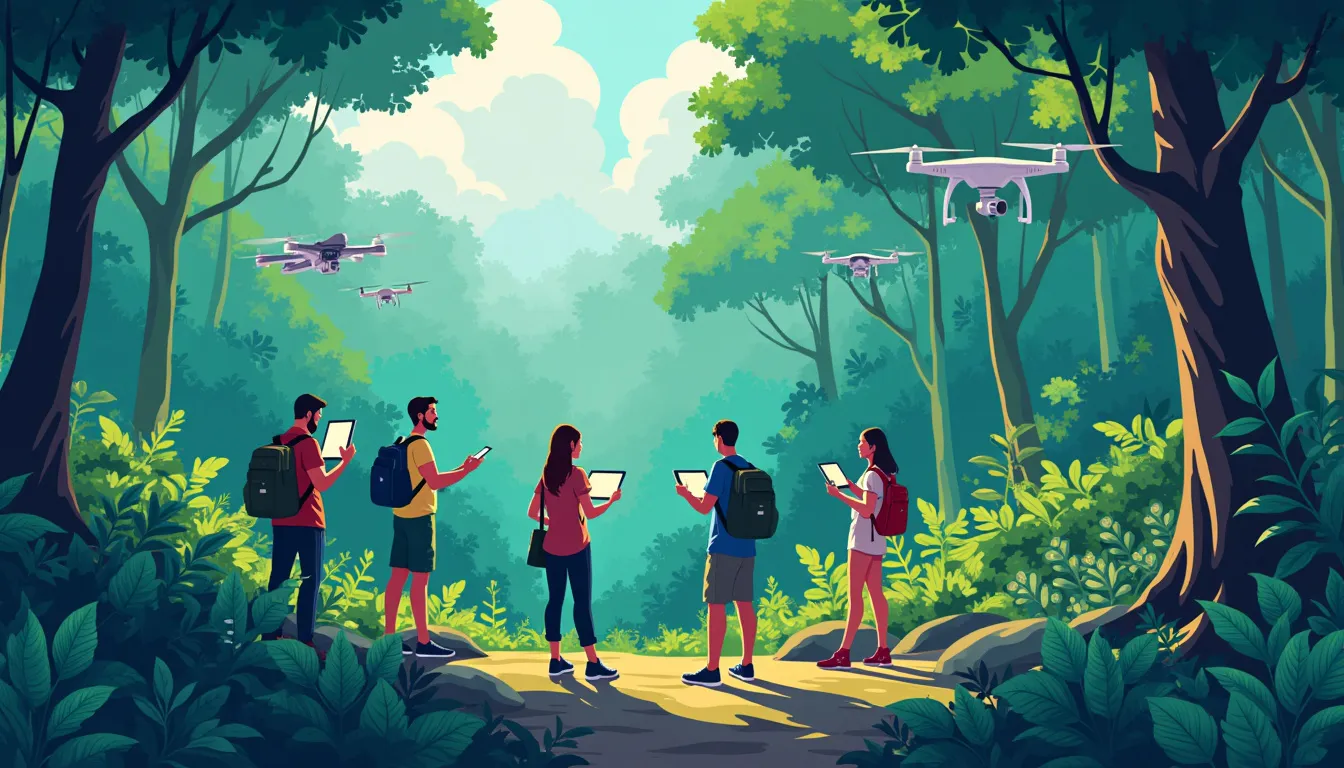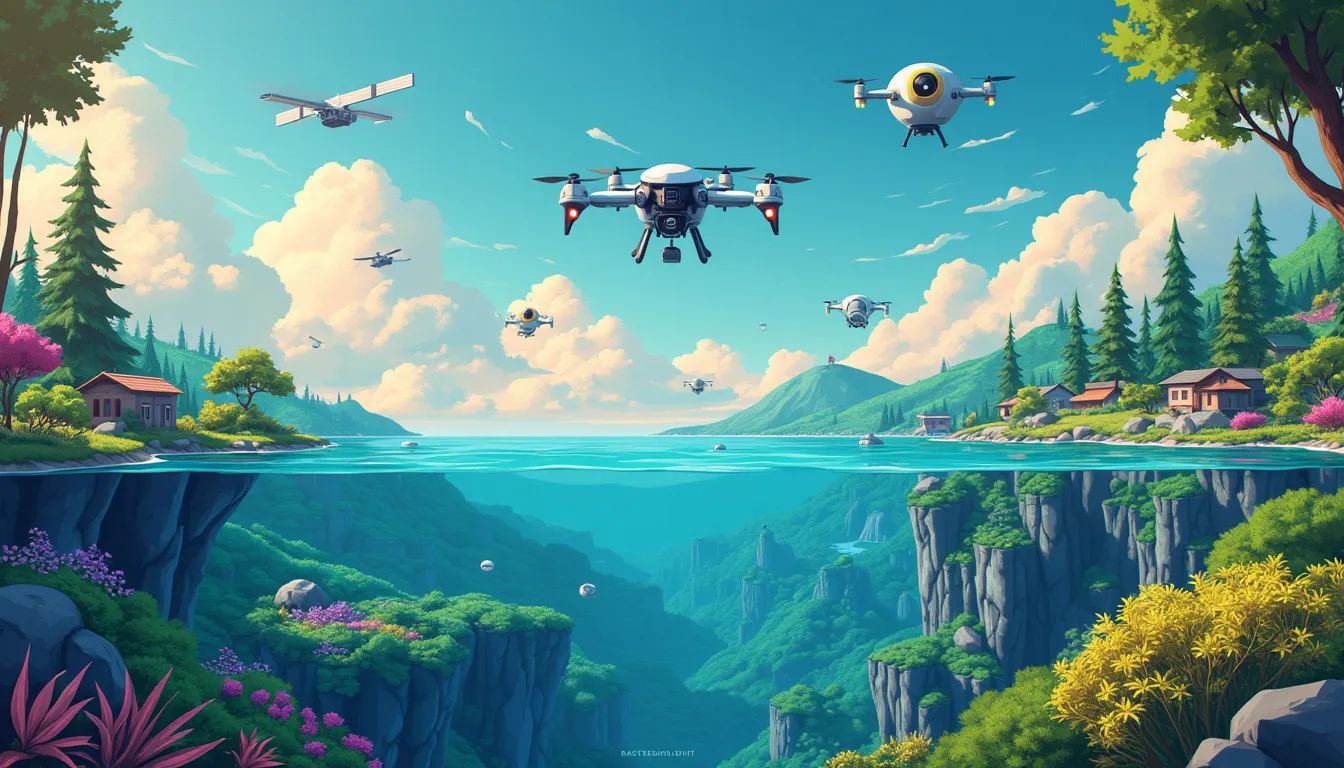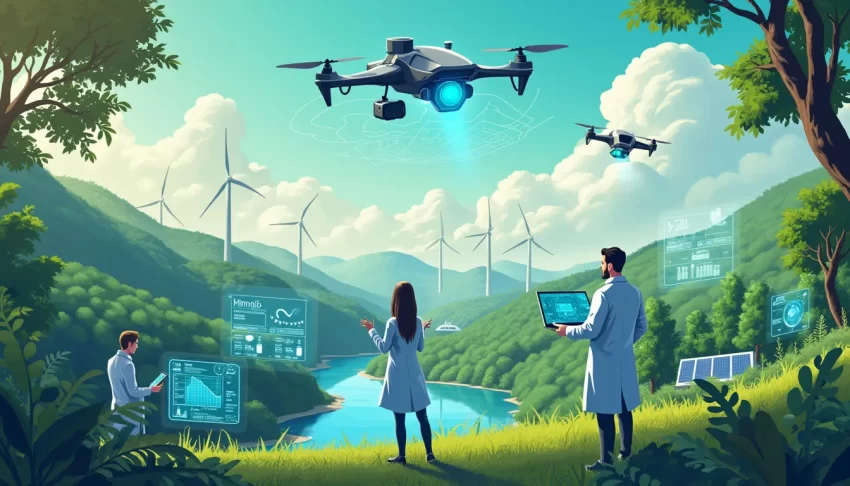Environmental monitoring is a crucial tool in our quest to protect the planet. By systematically collecting, analyzing, and interpreting data about the natural world, we can better understand and address the myriad challenges our environment faces. The primary goal of environmental monitoring is to safeguard ecosystems, ensure sustainable resource management, and mitigate the effects of human activities on the natural world.
In recent years, the importance of environmental monitoring has skyrocketed as we face unprecedented environmental challenges. From climate change and deforestation to pollution and biodiversity loss, our planet is under constant threat. However, thanks to remarkable advancements in technology, our ability to monitor and protect the environment has never been more powerful. These innovations offer new ways to gather and process vast amounts of environmental data with unparalleled accuracy and speed.
Technological advancements like satellite remote sensing, the Internet of Things (IoT), drones, and sophisticated sensors are revolutionizing the field of environmental monitoring. Satellites provide a bird’s-eye view of our planet, capturing critical information on a global scale. IoT devices enable continuous, real-time data collection, helping us respond to environmental changes more swiftly. Drones allow us to access and assess remote areas, while advanced sensors deliver precise measurements of environmental parameters.
The impact of these technological advancements extends beyond mere data collection. They play a pivotal role in shaping environmental policies, guiding conservation efforts, and fostering global cooperation. For instance, innovative environmental monitoring solutions have helped authorities prevent natural disasters, track pollution sources, and implement effective conservation strategies.
As we explore concrete examples of how these technologies are being used, we’ll see successful applications and inspiring stories from around the globe. We’ll analyze data-driven insights and examine how advanced monitoring has led to real-world environmental benefits. Moreover, we’ll look ahead to future innovations and discuss the challenges we may face in implementing these sophisticated systems. In a world where cooperation and informed action are key, understanding and leveraging the full potential of environmental monitoring is essential for a sustainable future.
In this journey towards enhanced environmental stewardship, each of us—whether an individual or a business owner—plays a crucial role. Together, we can adopt actionable strategies to support these technological advancements, ensuring the long-term health and vitality of our planet. Stay with us as we delve into the exciting and transformative world of advanced environmental monitoring.
Introduction to Environmental Monitoring
Explanation of Environmental Monitoring
Environmental monitoring is the systematic collection of data regarding the natural environment to understand its current condition and track changes over time. This practice encompasses various components, such as air and water quality, soil health, wildlife populations, and climate trends. The goal is to gather accurate and timely information to inform policy decisions, sustain ecosystem health, and ensure public safety. Essentially, environmental monitoring acts as the sentient guard over our natural resources, alerting us to emerging threats and helping us craft appropriate responses.
Importance and Goals of Environmental Monitoring in Protecting the Planet
Environmental monitoring plays a crucial role in maintaining the planet’s health. One of its primary goals is to mitigate human impact on the environment by providing data that can lead to more sustainable practices. Here are a few key importance areas:
- Pollution Control: By tracking air and water quality, environmental monitoring identifies pollution sources and trends, enabling targeted interventions. For instance, monitoring data can help pinpoint industrial emissions, prompting regulations that reduce contamination.
- Biodiversity Conservation: Monitoring wildlife populations and their habitats helps in protecting endangered species and maintaining biodiversity. Ecosystems are better managed when we understand the intricacies of species interactions and habitat needs.
- Climate Change Mitigation: Tracking greenhouse gas emissions, temperature fluctuations, and other climate-related data supports models predicting future climate scenarios, guiding efforts to reduce carbon footprints and prepare for climate impacts.
- Resource Management: Data on soil health, water levels, and forest conditions help in sustainable management of natural resources, ensuring they are available for future generations.
Moreover, environmental monitoring fosters public awareness and engagement. When people understand the state of their environment, they are more likely to adopt behaviors that contribute to its preservation. Businesses, too, benefit by aligning operations with environmental standards, reducing risks, and fostering a green reputation in a conscious market.
Overview of How Advancements in Technology Have Enhanced Monitoring Efforts
The landscape of environmental monitoring has evolved dramatically with advancements in technology. Gone are the days when monitoring was limited to manual data collection and simple observational techniques. Today, a myriad of sophisticated tools and methods enhances the precision, scope, and efficiency of monitoring efforts. Let’s explore how technology has revolutionized this vital endeavor:
Geo-spatial Technologies
One of the groundbreaking advancements is the advent of satellite remote sensing. Satellites equipped with sensors continuously orbit the Earth, capturing high-resolution images and data across various spectral bands. This capability allows for global-scale monitoring of climate variables, land use changes, deforestation, and more. For example, NASA’s Landsat mission has provided invaluable data for over four decades, allowing researchers to track changes in landscape patterns, urban growth, and agricultural practices.
Real-time Data Collection with IoT
The Internet of Things (IoT) has brought real-time data collection to the forefront of environmental monitoring. IoT devices, such as sensors and smart meters, are deployed in the field to gather continuous data on environmental parameters like air quality, water levels, and soil moisture. This real-time data enables rapid responses to environmental changes and enhances the accuracy of predictions and forecasting models. For instance, smart sensors strategically placed in water bodies can detect pollution levels, immediately alerting authorities to take corrective action.
Advanced Aerial Surveillance
Drones equipped with advanced cameras and sensors offer a new dimension to environmental assessment. These unmanned aerial vehicles can access hard-to-reach areas, providing detailed imagery and data for analysis. For instance, drones are used in forest management to monitor tree health, assess damage after natural disasters, and detect illegal logging activities. Their versatility and efficiency reduce the need for on-ground personnel, cutting costs and minimizing human risk.
Precision Sensors
Developments in sensor technology have markedly improved the precision of data collection. Modern sensors are highly sensitive and can detect minute changes in environmental parameters. These sensors are employed in various applications, from monitoring air pollutant concentrations to measuring radiation levels in the aftermath of nuclear incidents. By providing reliable and accurate data, these sensors support informed decision-making and policy formulation.
Overall, the integration of these technological advancements in environmental monitoring systems is a significant leap forward in our ability to safeguard the planet. From space-based observations to on-ground sensors, the seamless flow of data facilitates a nuanced understanding of environmental dynamics. This synergy empowers governments, organizations, and individuals to adopt strategies that are not only effective but also sustainable in the long run.
The journey of environmental monitoring from rudimentary methods to technologically advanced systems mirrors our growing recognition of the environment’s importance. These advancements epitomize the critical balance between growth and conservation, ensuring that while we progress, we do so with the Earth’s future in mind.

Cutting-Edge Technologies in Environmental Monitoring
In recent years, a remarkable evolution in technology has significantly enhanced the way we monitor and understand our environment. These advancements have not only increased the accuracy of data collection but also allowed for real-time analysis and response. Here, we will delve into some of the most revolutionary technologies that are transforming the landscape of environmental monitoring.
Satellite Remote Sensing and Its Impact on Global Monitoring
One of the most profound advancements in environmental monitoring is the utilization of satellite remote sensing. Satellites orbiting Earth are equipped with high-resolution cameras and sensors, enabling comprehensive data collection on a global scale. This technology provides invaluable insights into various aspects of the environment, including deforestation, urban expansion, and climate change.
For instance, the Landsat program, a series of satellites launched by NASA, has been instrumental in monitoring Earth’s land surfaces since the 1970s. Utilizing this data, scientists can track changes in land use, observe seasonal variations, and even detect early signs of environmental degradation. The ability to monitor large and remote areas from space has been critical in providing a holistic view of the planet’s health, guiding both global and localized environmental policies.
Role of IoT (Internet of Things) in Real-Time Data Collection
The Internet of Things (IoT) has revolutionized the field of environmental monitoring by enabling real-time data collection and analysis. IoT refers to the interconnection of everyday devices via the internet, allowing them to send and receive data. This technology has far-reaching applications, from monitoring air and water quality to tracking wildlife habitats and agricultural conditions.
For example, smart sensors strategically placed in cities can continuously monitor air quality, sending real-time data to central systems for analysis. This real-time monitoring facilitates prompt responses to pollution spikes, mitigating health risks and improving urban living conditions. IoT also supports precision agriculture by providing farmers with real-time data on soil moisture, temperature, and crop health, thereby enhancing resource management and increasing crop yields sustainably.
Advances in Drones and Aerial Surveillance for Environmental Assessment
Drones equipped with advanced imaging technology have become indispensable tools in environmental monitoring. These unmanned aerial vehicles (UAVs) offer a cost-effective and efficient means of surveying large areas, particularly those that are difficult to access on foot.
Environmental scientists use drones for a variety of purposes, such as mapping coastal erosion, monitoring wildlife populations, and assessing the health of forests. For example, drones equipped with multispectral cameras can capture images that reveal plant health by detecting light wavelengths invisible to the human eye. This data is crucial for identifying areas affected by disease or pest infestations, allowing for timely interventions.
Moreover, drones can be deployed quickly in response to natural disasters, such as hurricanes or forest fires, to assess damage and guide relief efforts. The ability to capture high-resolution images and data from above offers a comprehensive perspective that ground-based surveys cannot match, significantly enhancing our ability to protect and manage natural resources.
Development of Advanced Sensors for Precise Data Collection
The development of advanced sensors has been a game-changer in the accuracy and precision of environmental monitoring. These sensors are capable of detecting minute changes in environmental conditions, from slight variations in temperature and humidity to the presence of specific chemical compounds in the air or water.
For example, next-generation atmospheric sensors can measure greenhouse gas concentrations at finer scales than ever before, providing critical data for understanding and addressing climate change. Similarly, advanced water sensors can detect trace levels of pollutants, ensuring the protection of water quality and public health.
The application of biotechnology in sensor development has also opened new frontiers. Biosensors, for instance, use biological molecules to detect environmental contaminants, offering sensitive and specific ways to monitor pollutants. These innovations enable scientists and policymakers to make data-driven decisions, ensuring that environmental protection efforts are based on accurate and comprehensive information.
In conclusion, the integration of advanced technologies such as satellite remote sensing, IoT, drones, and sophisticated sensors has revolutionized environmental monitoring. These tools not only enhance our ability to collect precise data but also facilitate timely and effective responses to environmental challenges. By leveraging these technologies, we can better understand our planet and take proactive measures to preserve its health for future generations.

Case Studies: Successful Applications of Modern Environmental Monitoring
Rainforest Conservation in the Amazon
The Amazon rainforest, often referred to as the lungs of the Earth, has been under severe threat from deforestation and illegal logging. Traditional monitoring methods were unable to keep pace with the rapid changes occurring in this vast region. However, the integration of satellite remote sensing and AI-driven analytics transformed the landscape of environmental monitoring.
By utilizing high-resolution satellite imagery, organizations like Global Forest Watch have been able to detect deforestation activities in near real-time. These technologies have empowered local authorities and conservation groups to act swiftly, often intercepting illegal logging operations before they escalate. The data collected through satellite monitoring has not only facilitated immediate action but also contributed to long-term strategies for forest management and preservation. In one notable instance, Brazilian authorities used data from these advanced monitoring systems to reduce deforestation rates by nearly 70% between 2004 and 2012.
Air Quality Monitoring in Urban Areas
Urban air quality is a critical issue that impacts millions of people worldwide. Traditional air quality monitoring stations, while useful, often lack the coverage needed for comprehensive analysis. However, the advent of low-cost sensors and IoT technology has revolutionized how cities monitor and respond to air pollution.
Take the example of Los Angeles, a city historically plagued by smog and poor air quality. By deploying a network of IoT-enabled air quality sensors across the city, real-time data on pollution levels became accessible to both the public and policymakers. These sensors provided granular data, highlighting pollution hotspots and pinpointing sources of emissions. This data has been instrumental in shaping policies to reduce vehicle emissions, improve public transportation, and create greener urban spaces. Over time, these efforts have led to significant improvements in air quality, protecting the health of millions of residents.
Ocean Health and Marine Life Protection
The world’s oceans are an essential part of our ecosystem but face numerous threats from pollution, overfishing, and climate change. Modern environmental monitoring technologies have made significant strides in understanding and mitigating these issues.
One successful application of these technologies can be seen in the Great Barrier Reef. Researchers have employed drones and underwater sensors to monitor the health of coral reefs, track marine life, and detect pollution levels. These monitoring efforts have provided critical data that has guided conservation strategies, such as targeted coral planting and pollutant reduction initiatives. In another groundbreaking project, researchers used advanced acoustic monitoring techniques to track the movements and behaviors of marine mammals, leading to better protection measures for endangered species.
Combating Desertification in Sub-Saharan Africa
Desertification poses a severe threat to livelihoods and ecosystems in Sub-Saharan Africa. Traditional methods of monitoring land degradation were labor-intensive and often produced insufficient data. However, advancements in environmental monitoring have changed this scenario.
In countries like Niger and Burkina Faso, satellite imagery and AI-driven models have been used to analyze vegetation cover, soil moisture levels, and land-use changes. This data has been crucial in implementing sustainable land management practices. For instance, the Great Green Wall initiative, which aims to restore 100 million hectares of degraded land by 2030, heavily relies on data from these modern monitoring systems to assess progress and guide planting efforts. The project has already shown promising results, reducing the spread of desertification and improving food security in the region.
Flood Prediction and Response in Southeast Asia
Flooding is a recurring disaster in Southeast Asia, causing enormous human and economic losses. Modern environmental monitoring technologies have enhanced flood prediction and response capabilities in this region.
For instance, in Bangladesh, a country highly susceptible to flooding, researchers have combined satellite data, river gauge sensors, and weather forecasting models to develop an advanced early warning system. This system provides real-time flood forecasts, allowing communities to prepare and respond more effectively. The impact has been significant, with improved evacuation plans, better allocation of resources, and reduced loss of life and property.
Data-Driven Environmental Policies
The data collected from these diverse environmental monitoring efforts have been pivotal in shaping effective environmental policies globally. By providing accurate, real-time information, these technologies enable policymakers to make informed decisions that balance economic development with environmental stewardship.
For example, in Europe, data from extensive monitoring networks bolster the European Union’s commitment to the Green Deal, aiming to make the continent climate-neutral by 2050. This data has been essential in setting emission reduction targets, preserving biodiversity, and promoting sustainable agriculture.
In summary, the successful application of modern environmental monitoring technologies across various regions and projects has proven to be a game-changer. These advancements not only help in preventing and mitigating environmental damage but also provide the data necessary to drive impactful environmental policies and actions. Whether it’s conserving rainforests, improving urban air quality, protecting marine life, combating desertification, or enhancing flood response, modern environmental monitoring is at the forefront of protecting our planet.

Future Prospects and Challenges in Environmental Monitoring
Emerging Technologies and Innovations on the Horizon
As we look to the future of environmental monitoring, the horizon is bustling with promising technologies and innovations. One groundbreaking development is the integration of artificial intelligence (AI) with environmental sensors. AI algorithms can analyze vast datasets more efficiently than ever before, offering predictive insights that help preempt environmental crises. For instance, AI-driven satellite imagery analysis can predict deforestation patterns, allowing for timely interventions.
Blockchain technology also presents exciting prospects, especially in ensuring data integrity and transparency. By logging environmental data on a decentralized ledger, we can enhance the accountability and traceability of environmental reports. This could be particularly transformative for monitoring carbon credits and enforcing environmental regulations.
Furthermore, advancements in biotechnology may soon enable us to develop bio-sensors capable of detecting minute changes in ecosystems. Imagine sensors embedded in plant roots monitoring soil health or micro-sensors in water bodies tracking pollutant levels in real-time. These innovations could offer unparalleled detail and immediacy in our environmental assessments.
Potential Challenges and Solutions in Implementing Advanced Monitoring Systems
While the technological prospects are exhilarating, they come with a unique set of challenges that need addressing to optimize their implementation. Firstly, the issue of data overload is significant. The influx of high-resolution, real-time data necessitates the development of more robust data management and analysis frameworks. Here, leveraging cloud computing and big data analytics can offer scalable solutions.
Another challenge lies in the interoperability of various technologies and data formats. Environmental monitoring often requires integrating data from disparate sources like satellites, IoT devices, drones, and ground-based sensors. Developing standardized protocols for data exchange and fostering collaboration between tech developers, scientists, and policymakers is crucial for cohesive monitoring systems.
Financial constraints also pose a hurdle, particularly in developing countries that may lack the resources to invest in cutting-edge technologies. International funding mechanisms, philanthropic investments, and public-private partnerships can play pivotal roles in bridging this gap. For example, the Green Climate Fund has been instrumental in providing financial aid to support climate resilience projects globally.
Finally, there is the ever-present challenge of ensuring the ethical and responsible use of environmental monitoring technologies. It is imperative to create regulatory frameworks that protect environmental data privacy, prevent misuse, and encourage sustainable practices. Policymakers and technology developers must collaborate to create guidelines that balance innovation with ethical considerations.
The Role of Global Cooperation and Policy in Furthering Environmental Monitoring Efforts
Effective environmental monitoring transcends borders and mandates global cooperation. The Paris Agreement exemplifies how international treaties can galvanize nations to commit to shared environmental goals, such as reducing greenhouse gas emissions and enhancing climate resilience. Global cooperation ensures resource sharing, capacity building, and harmonization of monitoring practices across countries.
Transnational partnerships, such as the Global Environmental Monitoring System (GEMS), play a critical role in driving collective monitoring initiatives. By pooling scientific resources and data, such collaborations bolster our ability to understand and address global environmental challenges comprehensively.
Policy frameworks also play a pivotal role in enabling efficient environmental monitoring. Governments must enact legislation supporting environmental data sharing, fostering innovation, and mandating accountable reporting. Policies like the European Union’s Copernicus Regulation have been instrumental in streamlining space-based monitoring for various environmental applications.
Moreover, involving communities in monitoring efforts can democratize environmental protection. Citizen science initiatives, where local communities participate in data collection and reporting, ensure that monitoring is inclusive and grounded in local contexts. For instance, projects like the Great Barrier Reef Marine Park Authority’s Eye on the Reef program leverage community inputs to monitor and preserve the vibrant marine ecosystem.
In conclusion, the future of environmental monitoring hinges on the seamless fusion of emerging technologies, robust policies, and global cooperation. While challenges remain, the synergistic efforts of scientists, policymakers, technologists, and communities hold the promise of a sustainable and resilient planet. By staying at the forefront of innovation and collaboration, we can continue to protect and steward our environment for generations to come.
As we reflect on the extraordinary advancements in environmental monitoring, it’s clear that we’re at a pivotal moment in our relationship with the Earth. The leap from traditional methods to high-tech solutions like satellite remote sensing, IoT, drones, and advanced sensors is monumental, granting us the tools to closely watch and respond to the planet’s vital signs in real-time. These innovations not only provide a more comprehensive view of environmental changes but also empower us to take swift, informed actions to avert potential crises.
Consider the case studies we’ve examined: regions that once struggled with environmental degradation now have robust monitoring networks that inform better policy decisions and facilitate more effective conservation measures. The data extracted from these modern technologies is not just numbers on a page; it’s a lifeline that drives meaningful interventions, benefiting ecosystems and communities alike.
Looking to the future, the possibilities in environmental monitoring appear boundless. Emerging technologies promise even more precision and broader scope, enhancing our ability to detect and respond to environmental threats. However, the journey is not without challenges. Implementing these advanced systems requires significant investment, infrastructural support, and international collaboration. Equally, it calls for creating policies that are adaptable and forward-thinking, ensuring we are not merely reacting to problems but preventing them.
For individuals and businesses, the message is clear: sustainability isn’t just a buzzword, but a necessary practice for survival and prosperity. By embracing innovative monitoring technologies, we not only protect our planet but also secure a healthier, more resilient future. Whether it’s through supporting sustainable businesses, advocating for environmental policies, or simply adopting greener habits at home, every action counts.
In essence, the advancements in environmental monitoring are more than technological feats; they embody our collective commitment to safeguard our planet. By harnessing these powerful tools effectively and inclusively, we can ensure that our Earth thrives for generations to come. Let’s continue to innovate, collaborate, and act decisively, so our monitoring efforts translate into tangible, lasting positive impacts.
Support Us: Check out our recommended products on Amazon.

